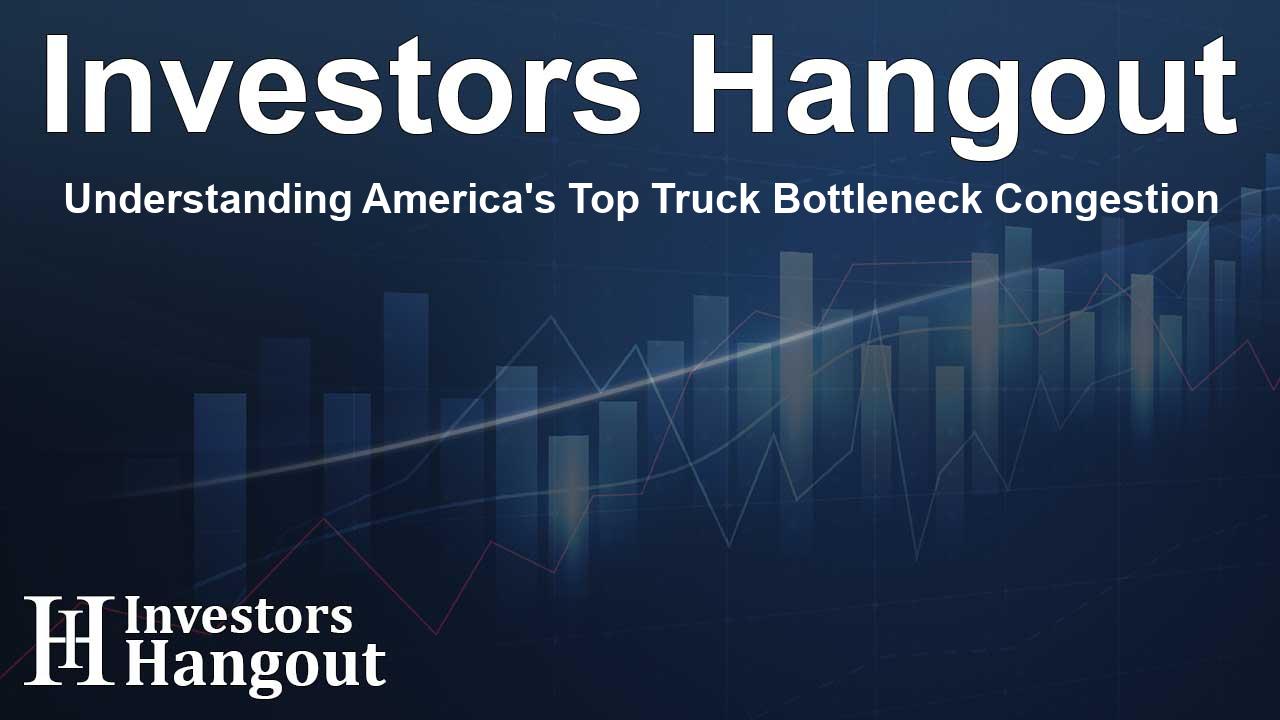Understanding America's Top Truck Bottleneck Congestion

Analyzing America's Truck Bottlenecks for Improved Traffic Flow
Data from the American Transportation Research Institute (ATRI) indicates critical ways to alleviate congestion, lower emissions, and enhance economic productivity. The organization has unveiled its 14th annual report detailing the most congested truck bottlenecks across the nation, spotlighting vital areas for future infrastructure investment.
Highlighting the Most Congested Areas
The recently published report revealed alarming congestion levels, with the exchange of Interstate 95 and State Route 4 ranking as the most overcrowded truck bottleneck in the U.S. This persistent traffic issue emphasizes the need for strategic investments in our nation's transport infrastructure.
Investing in Infrastructure
With Congress tasked to reauthorize surface transportation programs, ATRI’s analysis comes at a crucial time. The research demonstrates how allocating funds can drastically improve traffic flow. For example, the Jane Byrne Interchange in Chicago, previously regarded as a leading truck bottleneck, has made significant progress, witnessing a 25% increase in rush hour truck speeds post construction.
The Economic Cost of Congestion
Delays experienced by truckers translate into significant economic losses. ATRI President and COO Rebecca Brewster notes that the congestion amounts to the equivalent of 436,000 drivers being idle for a whole year. This issue is not insurmountable, as demonstrated by Illinois' successful efforts to rectify its traffic woes, turning the once number one bottleneck into a story of progress.
Data-Driven Analysis
The 2025 Top Truck Bottleneck List includes over 325 locations on the national highway system, ranking based on a comprehensive analysis of freight truck GPS data. This data supports the U.S. Department of Transportation's initiatives and further emphasizes where improvements are essential. While the bottlenecks represent the top 100 congested areas, ATRI ensures continuous monitoring of these critical locations.
Top Truck Bottlenecks for 2025
The consistent issue of congestion persists, particularly at the intersection of I-95 and SR 4, which has held its position as the most congested location since 2018. The other notable bottlenecks include:
- Chicago: I-294 at I-290/I-88
- Houston: I-45 at I-69/US 59
- Atlanta: I-285 at I-85 (North)
- Nashville: I-24/I-40 at I-440 (East)
- Atlanta: I-75 at I-285 (North)
- Los Angeles: SR 60 at SR 57
- Cincinnati: I-71 at I-75
- Houston: I-10 at I-45
- Atlanta: I-20 at I-285 (West)
The average rush hour speed for trucks has decreased, measuring at 29.7 miles per hour within these congested regions—a concerning shift indicating the need for immediate action.
Fuel Consumption and Environmental Impact
Not only does traffic congestion waste valuable time, but it significantly contributes to fuel inefficiency. Reports estimate that truck delays result in over 6.4 billion gallons of diesel consumed annually and additional carbon emissions exceeding 65 million metric tons. This environmental toll underscores the importance and urgency of addressing traffic congestion.
A Call to Politicians
As policymakers deliberate on the forthcoming federal highway bill, ATRI’s report provides a detailed strategy for tackling these pressing traffic bottlenecks. Chris Spear, the President and CEO of the American Trucking Associations, highlights that these congested areas exacerbate supply chain issues, adding approximately $109 billion every year to the costs of delivering everyday goods. Targeted investments in strategic locations will significantly enhance transport efficiency and overall quality of life.
Conclusion
ATRI's commitment to research and advocacy plays a fundamental role in improving freight transportation across the nation. The collected data not only assists in understanding congestion dynamics but also aids in developing actionable strategies for the future. Through collaboration among governments and stakeholders, we can transform our transportation systems for the better.
Frequently Asked Questions
What is ATRI’s role in analyzing truck congestion?
ATRI studies freight transportation to identify key bottlenecks, emphasizing areas where infrastructure improvements are necessary to enhance efficiency.
How does congestion impact economic costs?
Traffic delays add substantial costs to supply chains, exceeding $109 billion annually due to inefficiencies in transporting goods.
What are the top truck bottlenecks for 2025?
The report lists several, with I-95 and SR 4 at Fort Lee being the most congested, along with locations in Chicago, Houston, Atlanta, and Nashville.
Why is addressing truck bottlenecks important?
Improving truck bottlenecks plays a critical role in enhancing transport efficiency, reducing emissions, and ultimately benefiting the economy.
How can policymakers use ATRI's data?
Policymakers can utilize ATRI’s findings to prioritize funding for infrastructure projects that target alleviating identified bottlenecks, enhancing mobility.
About The Author
Contact Owen Jenkins privately here. Or send an email with ATTN: Owen Jenkins as the subject to contact@investorshangout.com.
About Investors Hangout
Investors Hangout is a leading online stock forum for financial discussion and learning, offering a wide range of free tools and resources. It draws in traders of all levels, who exchange market knowledge, investigate trading tactics, and keep an eye on industry developments in real time. Featuring financial articles, stock message boards, quotes, charts, company profiles, and live news updates. Through cooperative learning and a wealth of informational resources, it helps users from novices creating their first portfolios to experts honing their techniques. Join Investors Hangout today: https://investorshangout.com/
The content of this article is based on factual, publicly available information and does not represent legal, financial, or investment advice. Investors Hangout does not offer financial advice, and the author is not a licensed financial advisor. Consult a qualified advisor before making any financial or investment decisions based on this article. This article should not be considered advice to purchase, sell, or hold any securities or other investments. If any of the material provided here is inaccurate, please contact us for corrections.
